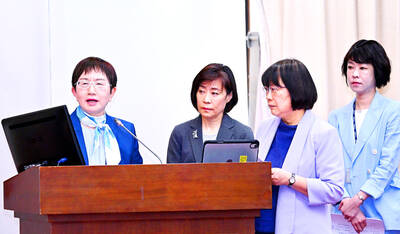Taiwan Beer (台啤), the leading beer brand in Taiwan, will be marketed in China next year, the Taiwan Tobacco and Liquor Corp (TTLC, 台灣菸酒公司) said on Friday.
TTLC chairman Wei Po-tao (韋伯韜) said Chinese authorities have completed screening of Taiwan Beer’s application for trademark registration and will announce official approval of the trademark on Feb. 6.
Wei predicted that the new market would help increase the beer’s total sales by 10 percent, or NT$3 billion (US$90.8 million), next year.
As of the end of last month, Taiwan Beer had seized an 81 percent share of Taiwan’s beer market, with its revenue expected to reach NT$26 billion for the year, Wei said.
TTLC president Hsu An-hsuan (徐安璇) said in the initial stage, Taiwan Beer’s marketing in China would focus on canned products exported directly from Taiwan and would target consumers in the southern provinces of Fujian and Guangdong, whose food preferences are similar to those of Taiwanese consumers.
In the future, the company would develop various beer flavors to cater to the preferences of local consumers in southern China, central China and northern China, and would outsource the production to Chinese manufacturers or establish partnerships with Chinese beverage firms , Hsu said.
TTLC said the beer would have the same packaging in China as it does in Taiwan, except that simplified Chinese characters will be used on the labels.

‘SWASTICAR’: Tesla CEO Elon Musk’s close association with Donald Trump has prompted opponents to brand him a ‘Nazi’ and resulted in a dramatic drop in sales Demonstrators descended on Tesla Inc dealerships across the US, and in Europe and Canada on Saturday to protest company chief Elon Musk, who has amassed extraordinary power as a top adviser to US President Donald Trump. Waving signs with messages such as “Musk is stealing our money” and “Reclaim our country,” the protests largely took place peacefully following fiery episodes of vandalism on Tesla vehicles, dealerships and other facilities in recent weeks that US officials have denounced as terrorism. Hundreds rallied on Saturday outside the Tesla dealership in Manhattan. Some blasted Musk, the world’s richest man, while others demanded the shuttering of his

TIGHT-LIPPED: UMC said it had no merger plans at the moment, after Nikkei Asia reported that the firm and GlobalFoundries were considering restarting merger talks United Microelectronics Corp (UMC, 聯電), the world’s No. 4 contract chipmaker, yesterday launched a new US$5 billion 12-inch chip factory in Singapore as part of its latest effort to diversify its manufacturing footprint amid growing geopolitical risks. The new factory, adjacent to UMC’s existing Singapore fab in the Pasir Res Wafer Fab Park, is scheduled to enter volume production next year, utilizing mature 22-nanometer and 28-nanometer process technologies, UMC said in a statement. The company plans to invest US$5 billion during the first phase of the new fab, which would have an installed capacity of 30,000 12-inch wafers per month, it said. The

Taiwan’s official purchasing managers’ index (PMI) last month rose 0.2 percentage points to 54.2, in a second consecutive month of expansion, thanks to front-loading demand intended to avoid potential US tariff hikes, the Chung-Hua Institution for Economic Research (CIER, 中華經濟研究院) said yesterday. While short-term demand appeared robust, uncertainties rose due to US President Donald Trump’s unpredictable trade policy, CIER president Lien Hsien-ming (連賢明) told a news conference in Taipei. Taiwan’s economy this year would be characterized by high-level fluctuations and the volatility would be wilder than most expect, Lien said Demand for electronics, particularly semiconductors, continues to benefit from US technology giants’ effort

Minister of Finance Chuang Tsui-yun (莊翠雲) yesterday told lawmakers that she “would not speculate,” but a “response plan” has been prepared in case Taiwan is targeted by US President Donald Trump’s reciprocal tariffs, which are to be announced on Wednesday next week. The Trump administration, including US Secretary of the Treasury Scott Bessent, has said that much of the proposed reciprocal tariffs would focus on the 15 countries that have the highest trade surpluses with the US. Bessent has referred to those countries as the “dirty 15,” but has not named them. Last year, Taiwan’s US$73.9 billion trade surplus with the US